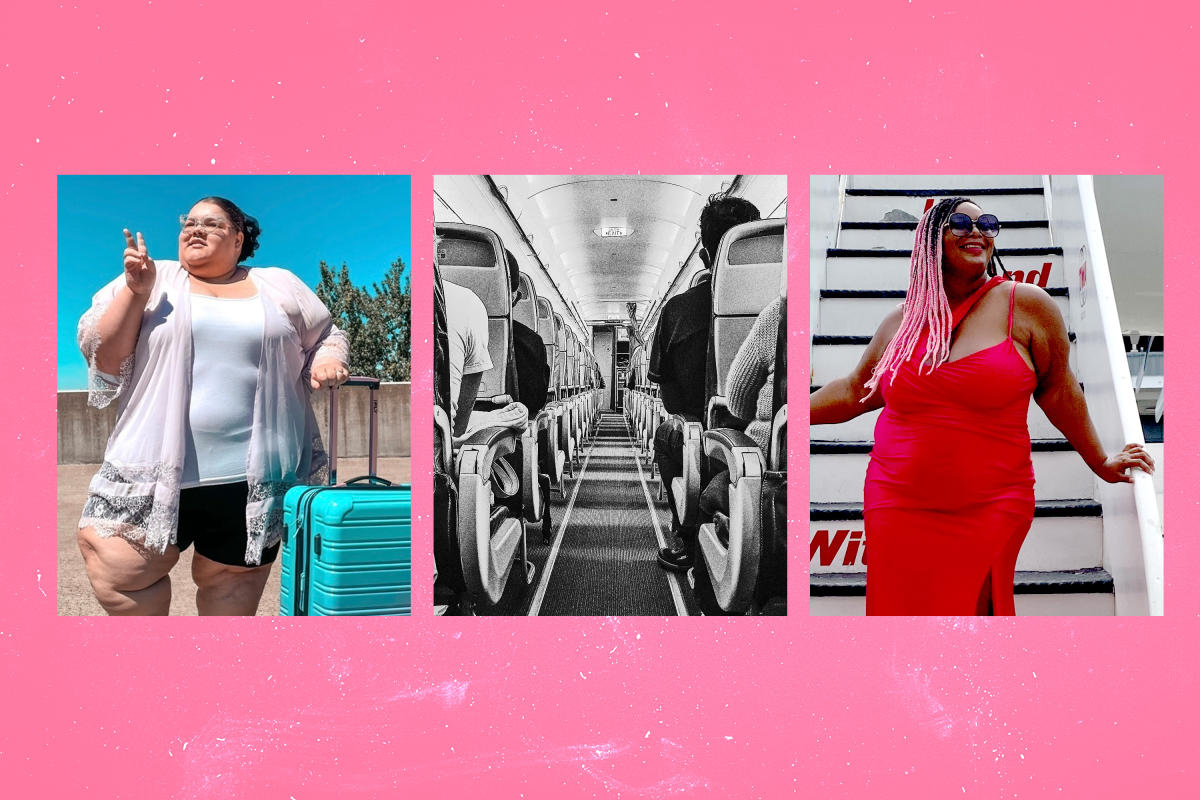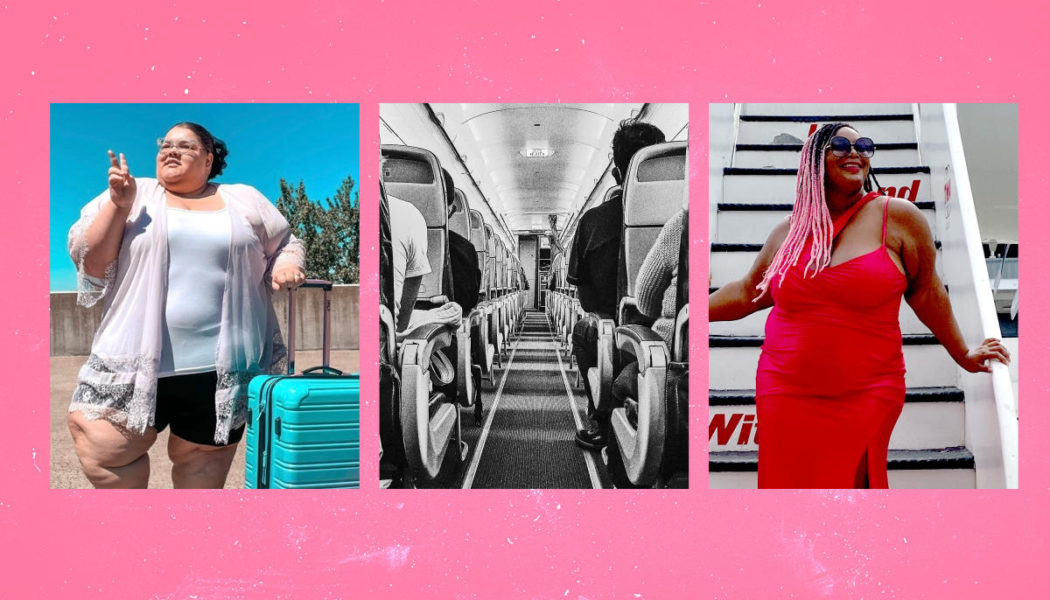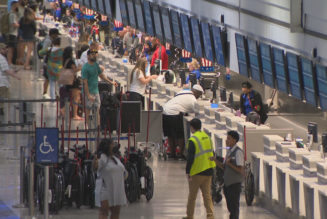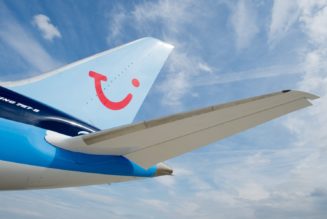
When Jae’lynn Chaney was 12, she flew as an unaccompanied minor from her mother’s home in Dallas to live with her dad in Pasco, Wash. It was just her second time flying, and she quickly realized that planes weren’t made to accommodate her body.
“I was sitting in my seat and went to click the seatbelt together, but it didn’t fit. I panicked,” she tells Yahoo Life. “I didn’t know what to do, so I hid the seatbelt underneath my stomach and rode the whole flight like that so nobody would know. I was afraid I was going to get kicked off the plane.”
The experience left the tween passenger with a feeling of otherness. “I was by myself and didn’t feel comfortable enough to ask the flight attendant. It was a really hard thing to overcome,” she says. Chaney, now 27, is just one of many travelers to face stigma and various other burdens when traveling.
How size standards affect travelers
The size of aircraft and seats have faced general complaints from passengers who find it difficult to be comfortable during air travel. For plus-size passengers, however, it’s not just discomfort but also inaccessibility that they face when they have to or want to fly.
The length of a seatbelt is just one piece of that — to which flight attendants will provide seatbelt extenders to those who ask. The tight squeeze of an aircraft’s aisle and seats is another, which hasn’t yet been addressed by airlines across the board.
Southwest Airlines, for example, has a policy of accommodating passengers of size.
“If you don’t fit within a seat’s armrests, you will have the option to have a complimentary seat (or seats) that you do not have to pay for,” says Chaney, who works as a plus-size travel guide. The seats can be obtained the day of travel if the flight isn’t full. They can also be purchased and secured during booking with specific information inputted online. “Once you’re done traveling, you can call or go to the ticket counter and you can request your refund for that second and third seat.”
Alaska Airlines’s policy has just one option that requires passengers of size to purchase their additional seat(s). Refunds are provided after travel is complete. “Those policies are really the only ones that exist here in the U.S.,” Chaney says. Others, like Hawaiian Airlines, can’t guarantee extra seats and state the ability to refuse boarding for a passenger of size if there isn’t a suitable option available at that time.
The lack of any industry-wide standards protecting these passengers means that many don’t bother to travel. Unique Gibson, who plans events and travel for “super-sized big, beautiful women,” created her business, Juicy Peaches SSBBW Events, for that very reason.
She recalls her mother dying at 48 years old from what doctors labeled morbid obesity. “I started just thinking about her life in comparison to mine. What I had done with my kids and what my brothers and I didn’t get to do with my mom,” Gibson tells Yahoo Life. “[My mother] never traveled.”
Instead, she “lived vicariously” through people who had access to spaces like airplanes. Gibson wanted to find that opportunity for everyone so nobody would have to miss out because of their size.
The standard aircraft sizes might not be changing, but her efforts in highlighting the resources that cater to passengers of size is providing them the opportunity to board a plane. Annette Richmond, founder of Fat Girls Traveling, is doing similar work with the goal of “encouraging people to get out of their comfort zone and to do something different, try something different, go somewhere different,” says Richmond.
The burden placed on plus-size bodies
While the accessibility of an aircraft might be the most obvious barrier to entry, Richmond points out that “travel begins as soon as you step out of your house.” This means that plus-size travelers will face obstacles prior to getting to their gate. Hence, the accommodations that Gibson’s concierge service takes into consideration.
When booking travel for plus-size individuals, Gibson first focuses on the necessary in-flight seating. Window seating is preferable with the option of additional seats on a nonstop flight, says Gibson. Chaney recommends using SeatGuru to confirm specific seat sizes. But it doesn’t end there.
Calling airports ahead to make sure that passengers have access to bariatric wheelchairs and staff to assist them through the airport is another responsibility that Gibson takes on for her clients. Otherwise, they’re required to do it themselves, which many have immense anxiety about doing. “People have canceled their trip because they don’t want to call an airport and say, ‘I’m over 400 pounds,'” she says. “So I’ll make calls, I’ll make sure that you’ve got the wheelchair, I’ll make sure that [airport staff] know what to expect. And if they know what to expect, you don’t have to worry about the looks.”
Gibson also encourages her clients to pay for TSA PreCheck in an effort to get them through security lines faster, to pack light carry-on bags because “it’s enough to carry us,” she says, and to properly prepare their bodies for the stress that comes with getting through an airport, squeezing through an aircraft’s aisles and sitting through the flight.
“You want to start taking extra steps every day to build up your strength and endurance … starting to eat less sodium before so that you don’t have any swelling or bloating so that your body truly is in its best shape,” she says. “It has everything to do with efficiency,” because comfort is likely out of the question.
The preparation is ultimately intended to create a sense of control over the otherwise anxiety-inducing experience. However, there is much that cannot be controlled, including the perpetuation of weight stigma by other travelers and airport staff.
“You can plan and plan and plan, but you’re gonna still be anxious that day when you get to the airport because things can go differently,” says Chaney, explaining that the entirety of the experience “perpetuates the whole idea that fat people don’t deserve to travel and this space isn’t built for us. So when we are there, we are seen as an inconvenience, and many people will treat us as such. And that’s very hard to deal with.”
Representation matters
Chaney is now working to change Federal Aviation Administration (FAA) policy with the creation of a petition demanding that the FAA protect plus-size travelers. She also hopes to create a specific business certification that’s focused on making the world more accessible and inclusive to people of all sizes in the future. But some of her most important work continues to be providing travel resources and content for fellow plus-size individuals so that they feel seen.
That representation is the crux of Richmond’s work through Fat Girls Traveling, where she has expanded to host a size-inclusive retreat called Fat Camp and fat-positive travel tours. “I’m focused on developing travel opportunities for marginalized people,” she says, noting that having a safe space or sense of camaraderie is a major part of that. “Within our group, there is a sense of safety because we all are so similar and we all are walking around in bigger bodies. And if people are staring, at least they’re staring at all of us because we feel cute as f***.”
Even seeing their photos on social media is a “tremendous help” to plus-size people looking to travel.
“There are so many who have written [travel] off as a possibility for them. So when they can see themselves in the seat and know that, ‘OK, she was able to do it. Even if she was a little uncomfortable, she got there. She made it to her son’s graduation or to her vacation, and I can possibly do it too,'” says Gibson. “It’s important that everybody see us, that they see the representation and that they know that there a place that they can come to for support in this process.”









